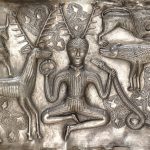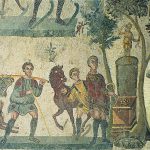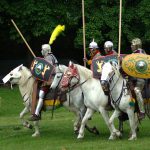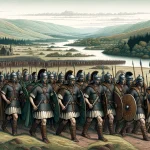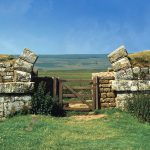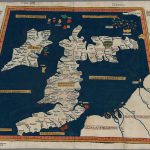Ribchester (Bremetenacvm Veteranorvm) Roman Fort
Flavian Auxiliary Fort (AD 69–96) and Vicus
The Roman Settlement of Ribchester
The Latin name for Ribchester has the suffix Veteranorum, which indicates that veterans were settled here. When the men of the unit stationed at Ribchester were retired from service, it appears that they were granted the use of the marshland lying close to the fort in the nearby Fylde country. They cut a system of drainage channels and thereby recovered large amounts of rich arable land which was used to grow abundant crops, and to raise cattle and horses.
This land was previously owned by the Brigantes tribe, and may have confiscated during the reign of Antoninus Pius (c.154-5AD), for an aside by Pausanias states:
Antoninus never willingly involved the Romans in War … he also removed much of the territory of the Brigantes in Britain because they had embarked upon an armed invasion of the region of Genounia¹, which was subject to the Romans.” Pausanias Description of Greece, VIII.43 3-4.
- The location of Genounia is unknown.
Equally, the lands in question may have been held as part of an Imperial Estate since the late 70’s, when Cn. Julius Agricola swept through the region during the campaigns prior to his conquest of lowland Scotland, and only allocated later when a clear use for the area had been identified.
The first grants of land to veteran soldiers at Bremetenacum started c.200AD, but the official status of the settlement is uncertain; it certainly was not a colonia, probably not a municipium, though it may have been the centre of an administrative pagus. Other Brigantian territories annexed during the Antonine campaigns were possibly employed to establish the Civitas Carvetiorum in Cumbria. It is also possible that the existing pagus centred on Corstopitum (Corbridge) was up-graded at this time, to form a separate civitas in the north-east of England.
Numismatic Evidence from Ribchester
There have been 151 coins recovered from excavations at Ribchester (including seven illegible copper coins, four of which may be attributed to Vespasian), ranging from six republican silver issues (pre 44BC) to a single copper issue of Valentinian I (Imp. 364-375AD), also 151 casual finds ranging from a single silver republican issue to a gold coin of Gratian (Imp. 367-383). Of the 299 coins which can be dated, 81 of them are Flavian, 43 of the period 259-275AD, 37 Trajanic, 32 Hadrianic, 27 of Constantine and 20 Antonine, with no coins issued after c.378.
A foundation at least as early as Agricola’s governorship would appear to beyond question: however, the very large showing of Flavian coins together with not insignificant numbers of pre-Flavian issues [19] leaves alive the possibility of some pre-Flavian activity.” (Shotter, p.34)
The Auxiliary Fort
RIB 592 - Building stone of the Twentieth Legion
The Twentieth Legion Valeria Victrix built this.
FECIT
Huebner did not see the boar on the stone at St. John’s College, and wrongly thought that it was different from the stone which Whitaker recorded at Browsholme. There was no such stone at Browsholme in 1936 (R.G.C.).
The original Flavian timber-built fort continued to be occupied throughout the reigns of Trajan and Hadrian, as attested by samian ware dating to both these periods. By the time of Calpurnius Agricola the fort had been replaced in stone. The fort was damaged around 196/7AD and the H.Q. building destroyed, but a Severan inscription records building restorations to both the fort and at least one temple erected outside the defences. Both the fort and its temples were destroyed around 301-306, though repairs were effected at sometime during the mid-fourth century. The last coins from the site are those of Gratian (367-383), and the last dateable pottery was produced in the late-fourth century.
The fort measures 550 by 410 feet (168 x 125 m) within the defences, having an occupation area of just under 5¼ acres (c.2 ha). Defences consisted of a twenty foot wide double-ditch system separated by a narrow berm from the rampart, which was also twenty feet wide and made of puddled clay laid on a raft of oak beams and shingles as a protection against the underlying damp ground. The gateways and corner-towers were of timber, and so it seems, were the original interior buildings, as no traces were found during excavations in 1928.
RIB 589 - Dedication to Marcus Aurelius and Lucius Verus
For the Emperor Caesar Marcus Aurelius Antoninus … and for the Emperor Caesar Lucius Aurelius Verus, …, Augusti, a detachment of the Cavalary of Upper Germany …, Sextus Calpurnius Agricola, the emperors’ propraetorian legate, (set this up).
IMP CA[ ...]EL VE[...]
VEX EQ [... ]IAE [...]
SVP SE[ ...]RN [...]
Calpurnius Agricola was governor of Britain from about 163 to about 166 (Birley in Askew Coinage 81) during the joint reign of Marcus Aurelius and Lucius Verus (A.D. 161-9). Addenda from RIB+add. (1995): Speidel (Brit. xviii (1987), 233-5) notes that Calpurnius Agricola is now attested as legate of Upper Germany in A.D. 158 (AE 1986, 523).
Severan Reconstruction
RIB 593 - Centurial stone of Titius
From the tenth cohort the century of Titius (built) 27 feet of the work.
𐆛 TITIANA
O P
XXVII
The adjectival form Titiana should imply that there was a vacancy in the command of this century till recently filled by the centurion Titius (Birley, Cumb. Westm. AAST 2nd Ser. 51 (1951) 71). But Titiana could also be derived from Titianus. In this case the centurion Titianus cited on the leaden tag at Chester (JRS xxi (1931) 250 no. 12 = RIB 2410.7) may well be identical.
RIB 591 - Dedication to Septimius Severus, Caracalla, and Geta
[For the Emperor Septimius Severus …] Augustus [and the Emperor Marcus Aurelius Antoninus …] Augustus [and for Publius Septimius Geta, most noble] Caesar, … under Gaius Valerius Pudens, emperor’s propraetorian legate.
AVG [...]
AVG [...]
⟦CA[...]⟧ [... ...]
RIO [... ...]
AV[ ...]
The two Augusti are Septimius Severus and Caracalla. Geta’s names, incl. Ca[esari], were erased in 212. The closest analogy for its restoration seems to be RIB 722 (Brough-by-Bainbridge). Addenda from RIB+add. (1995): Birley and Stephens both rightly object to restoring the legion’s name in full; there is no instance from Britain (RIB 589 can be excluded). If o can be read in 4, Birley’s neater restoration is to be preferred since ‘Germania Superior’ is abbreviated in all six instances from Britain.
The columns of the courtyard portico in the principia at Ribchester had deep grooves cut into their sides, which were probably intended as support-slots for timber screens or panels in the spaces between the columns. The elaborate stone forehall of the principia has been dated to the Severan period. The double granary at Ribchester is also worthy of note as two different construction methods were used in the separate halves of the building, one side had stone pillars supporting the floor, whilst the other had only a single sleeper wall which ran longitudinally down the centre of the structure. The granaries had a massive stone loading-platforms jutting out over two metres from the ends of the buildings, which were probably covered by a timber roof. The septic tank into which the latrines drained has been identified, though the latrines themselves have not yet been excavated.
RIB 587 - Dedication to Severus Alexander and Julia Mamaea
To … for the welfare of our Emperor Caesar Alexander Augustus and of Julia Mamaea the mother of our Lord (the Emperor) and of the army, under the charge of Valerius Crescens Fulvianus, his pro-praetorian governor, Titus Floridius Natalis, legionary centurion and commandant of the unit and of the region, restored from ground-level and dedicated this temple from his own resources according to the reply of the god ..
[...]L IṂ[ ... ] ⟦[...]EX[...]⟧ [...]
[... ...]T[...]IS D N ET CASTR SV[ ...]
VAL CRESCENTIS FVLVIANI LEG EIVS PR[ ...]
T FLORID NATALIS 𐆛 LEG PRAEP N ET REGI[...]
TEMPLVM A SOLO EX RESPONSV [...]
STITVIT ET DEDICAVIT D[ ...]
The left-hand and lower margins survive. The right-hand margin has been dressed off, probably in Roman times. From the broken upper margin three fragments survive ]ro[, ]lim[, and ⟦al]ex[andri⟧ | …]t[…The deleted letters ex in l. 2 seem to date the text to Severus Alexander (A.D. 222-35). As the governors from 222 to 225 are known (Atkinson, JRS 12 (1922) 71; Birley in Askew Coinage 82), the inscription can be restricted to A.D. 225-35. The phrase ex responsu strongly suggests the cult of Jupiter Dolichenus (Richmond, op. cit. 25).
The Ribchester Garrison
RIB 588 - Fragmentary dedication
… , centurion of the Twentieth Legion Valeria Victrix, with his own willingly and deservedly fulfilled his vow.
[.] C LEG X[ ...]
CVM SVIS V
S L M
No commentary.
An altarstone dedicated by a centurion of Legio XX Valeria Victrix is not proof that the legion was stationed here. The Ribchester fort was built by men of the Twentieth, that much is certain (vide RIB 592 supra), but what is also apparent is that it was built for a regiment of auxiliary cavalry, not a cohort of infantry. The unknown dedicator of this altarstone was very likely seconded to the staff of the cavalry prefect, presumably in a senior consultative or advisory position, as he was allowed to take his family along.
RIB 586 - Altar dedicated to the Mother Goddesses
To the Mother Goddesses Marcus Ingenuius Asiaticus, decurion of the Second Cavalry Regiment of Asturians, willingly, gladly, and deservedly fulfilled his vow.
M INGENVI
VS ASIATI[...]
DEC AL II AS[...]
[...] S L L M
No commentary.
Perhaps the first occupants of the Ribchester fort were Ala II Asturum, a nominal five-hundred strong auxiliary cavalry unit recruited from among the Astures tribe of north-western Spain.
RIB 595 - Funerary inscription of cavalryman of Ala Samartarum
To the spirits of the departed … decurion (?) of the Cavalry Regiment of Sarmatians ..
[...]C AL SARMATA[...]
No commentary.
This unit was a Sarmatian cavalry regiment who replaced the Second Asturian Wing. This was one unit of perhaps seven, totalling 5,500 tribesmen in all, who were drafted from among the savage tribes living beyond the Danube and sent to Britain by Marcus Aurelius in 175AD. These people had previously held Roman client status, but at this particular time were not under direct Roman control. It has been suggested that Ribchester later became a Roman military horse-breeding/training centre, which drew-upon the particular tribal skills of the Sarmatians.
RIB 594 - Funerary inscription for Aelia Matrona, Marcus Julius Maximus, and Campania Dubitata
By this earth is covered she who once was Aelia Matrona (who) lived 28 years, 2 months, 8 days, and Marcus Julius Maximus, her son, (who) lived 6 years, 3 months, 20 days, and Campania Dubitata, her mother, (who) lived 50 years. Julius Maximus, singularis consularis of the Cavalry Regiment of Sarmatians, as husband set up this memorial to his incomparable wife, and to his son most devoted to his father, and to his most steadfast mother-in-law.
AEL MATRONA QVOND
VIX AN XXVIII M II D VIII
ET M IVL MAXIMVS FIL
VIX AN VI M III D XX ET CAM
PANIA DVB[...]TATAE MATER
VIX AN L IVL MAXIMVS
S C ALAE SAR CONIVX
CONIVGI INCOMPARABILI
ET FILIO PATRI P[...]ENTIS
SIMO ET SOCAERE TENA
CISSIME MEMORIA P
Camden assigned it to Ribchester, on account of the mention of ala Sarmatarum.1. Engström (Carm. Epigr. 419) places this among his commatica, or shortened metrical lines, as ll. 1-2, his terris tegitur … quondam may come from a hexameter.8. A singularis consularis was a ‘governor’s bodyguard’ either mounted (eques) or infantry (pedes), seconded from an auxiliary unit; he also served as a courier and special emissary.10. patri: Huebner regards it as error for pater; Watkin and Atkinson make it depend on pientissimo.11. socaere for socrae, a variant for dative of socrus: see CIL viii 14683 (ILS 6824).
An eighteenth-century historian paints a barbarous picture of the Sarmatiae, which is worth quoting at length:
… The Sarmatians were a savage uncivilized nation, … naturally warlike, and famous for painting their bodies to appear more terrible in the field of battle. They were known for their lewdness, … They generally lived on the mountains without any habitation except their chariots, … They lived upon plunder, and fed upon milk mixed with the blood of horses.
RIB 583 - Dediction to Apollo Maponus and Gordian's Own Unit of Sarmatian cavalry
To the holy god Apollo Maponus for the welfare of our Lord (the Emperor) and of Gordian’s Own Unit of Sarmatian cavalry of Bremetennacum Aelius Antoninus, centurion of the Sixth Legion Victrix, from Melitene, acting-commander and prefect, fulfilled his vow willingly, deservedly. Dedicated 31 August in the consulship of the Emperor Our Lord Gordian for the second time and of Ponpeianus.
[...]POLLIÍ¡NÍ¡I ▸ MAÍ¡PON
[...]O SALVTáE ▸ D ▸ N
[...] N ▸ EQQ
The title Gordiani dates the inscription to the reign of Gordian (A.D. 238-44). 10. Melitenis: sc. (castris). Melitene, on the River Euphrates, where legio XII Fulminata was in garrison. Addenda from RIB+add. (1995): For the date cf. RIB 882 and 883.
The dedicatory inscription to Apollo shown above, was dedicated by a praepositus regionis, which proves that the local garrison was still considered a special case, and perhaps a potential flash-point, in the middle of the third century. Another dedicatory inscription by a man of this rank has also been unearthed at the Ribchester fort (vide RIB 587 supra).
It was the Sarmatian peoples who, under their tribal identities as Huns, Goths, Vandals and the like, were ultimately responsible for the ruin of the Roman empire in the third and fourth centuries.
Cuneus Sarmatarum – The Formation of Sarmatae
“The Formation of Sarmatians at Bremetenacum.”
In the Notitia Dignitatum of the fourth century, the Ribchester entry is listed under the command of the Dux Britannia, curiously under the heading ‘upon the line of the Wall’, even though Ribchester lies about 70 miles (110km) to the south of Hadrian’s monument. The Cunei were small, irregular auxiliary units predominant in the later Roman empire, who sported a variety of weapons skills; the Ribchester Cuneus was a cavalry unit possibly enlisted from among the sons and grandsons of the original Sarmatian veterans who settled in the area.
The Gods of Roman Ribchester
RIB 584 - Altar dedicated to Mars Pacifer
To Mars the Peace-bringer … set this up in accordance with her vow.
RO MARTI
ELEGA VR
BA POS
VIT EX VO
TO
For Mars Pacifer see CIL ix 5060, and Panofka, Arch. Zeit. 15 (1857) 30.
Several gods from the classical pantheon are celebrated at Ribchester. There are single altars dedicated to the war god Mars (vide RIB 584 supra), to the goddess Victory (vide RIB 590 infra), and to the sun god Apollo (vide RIB 583 supra). There is also an altar dedicated both to Mars and to Victory (RIB 585; not shown), and another dedicated to the Germanic Mother Goddesses (vide RIB 586 supra).
In the inscription shown above, the equation SEPR = Sempronius is tentative, and the name cannot be linked with any of the ordinary consuls of the period. This may have been the gens or family-name of the altars dedicator.
Milestones or Honorific Pillars from Ribchester
D N IMP CAES G MESSIO Q DECIO TRAIANO:
“For our lord Imperator Caesar Caius Messius Quintus Decius Trajanus.”sup1;”
IMP CAES M ANTONIO GORDIANO:
“For Imperator Caesar Marcus Antonius Gordianus.²”
D N IMP CAES G MESSIO Q DECIO TRAIANO:
(RIB 2268; dated: 249-251AD)
IMP CAES M ANTONIO GORDIANO:
(RIB 2269; dated: 238-244AD)
- The emperor Decius ruled from the death of Philip the Arab in Sep/Oct 249AD until he was killed in Battle against the Goths at Abrittus in Moesia June 251.
- The emperor Gordian III was named Caesar (i.e. heir to the emperorship) in March 238AD, two months after his father and elder brother (Gordian I and II) had died during the defence of Carthage. He became Imperator in May the same year, following the murder by the praetorians at Rome of Pupienus and Balbinus, the emperors chosen in opposition by the senate. Gordian was only 13 years old when he became sole emperor, and was to enjoy this position for only six years before he himself was murdered near Circesium in Mesopotamia during February 244.
Ribchester/Bremetenacum in 1969
Excavations conducted in 1969 outside the NW defences of the fort found occupation evidence from the mid/late-1st to the late-2nd centuries AD, including at least two periods in Flavian/Trajanic times and several others of later date. (See: Britannia I (1970) p.281 & plate.XXXIIa).
During excavations over the years a number of animal bones have been uncovered, including those of domesticated Ox, Sheep, Goat and Pig, also game such as Red Deer and Roe Deer; the latter very likely being hunted and killed for sport and to supplement the diet. In addition, various types of fowl, such as Chicken, Goose and Swan were evidently eaten. (See the article: The Roman Military Diet by R.W. Davies, in Britannia II (1971) pp.122-142).
Excavations in 1970
SD649350 – The western defences and part of the interior of the fort were investigated (by Manchester University) in 1970. There were 4 phases of development discernable in the interior investigations: A substantial timber building was the first to be erected on the site, possibly the Flavian praetorium, in which case the original fort faced north. This building was later overlain by a number of barrack-blocks or stables during the Trajanic period. These types of building would have resided in the retentura of the succeeding fort, which therefore faced east. During the late-fourth century the ground went unused, although it is known that the fort continued to be manned by a reduced garrison.
The Structural Phases
- The earliest defences were erected around 78AD and consisted of two external ditches and a rampart of turf blocks – each about a foot (0.3m) square – laid upon a timber corduroy foundation, and interleaved with brushwood. A single gateway was constructed of timber and controlled egres through a single carriageway.
- During Trajanic times the rampart was cut-back at the front and revetted with a stone wall. At the same time a double-gateway of stone with guard-chambers was constructed, and the inner ditch was back-filled.
- At a later period the south gate was blocked off and sharpened stakes were planted in the bottom of the remaining (outer) ditch.
- In the last phase, the gateway was completely blocked-up and the building turned into a cook-house. At the same time another ditch with a flat bottom was dug beyond the remaining one. This building phase occurred sometime in the 4th century.
Bremetenacum Veteranorum The Hilltop Settlement of the Veterans
The name of the fort first appears in Iter X of the Antonine Itinerary, “The route from Glannoventa (Ravenglass, Cumbria) to Mediolanum (Whitchurch, Shropshire)”. The name is recorded as Bremetonaci, some twenty-seven miles from Calacum (Burrow in Lonsdale, Lancashire) and twenty miles from Coccium (Wigan, Lancashire). The Notitia Dignitatum of the 3rd/4th centuries supplies the name Bremetenraco, which is listed between the entries Calunium (Lancaster, Lancashire) and Olenacum (Elslack, North Yorkshire), both of which sites are only tentatively identified. The Ravenna Cosmology (R&C#124) of the seventh century lists the name as Bresnetenaci Veteranorum, between the entry for Bravoniacum (Kirkby Thore, Cumbria) and the unknown Pampocalia entry.
When the Domesday Book was produced in 1086, Ribchester was even then known by its modern name and is recorded as Ribelcastre, which translates simply as ‘Roman Fort on the River Ribble’; the Roman name had apparently been forgotten in the five-hundred or so years between the end of Roman Britain and the arrival of the Normans in the eleventh century.
The etymology of the name Bremetenacum is difficult, but may stem from the Welsh/Gaelic word brez ‘hill’ coupled with a form of the Latin teneo meaning ‘to occupy, retain, settle’. The full name would therefore be something along the lines of ‘the Hilltop Settlement of the Veterans’
References for Bremetenacvm Veteranorvm
- Roman Coins from North-West England by David Shotter (Lancaster 1990) pp.30-36.
- Britannia ii (1971) p.255; A.E. 1970;
- The Roman Inscriptions of Britain by R.G. Collingwood and R.P. Wright (Oxford 1965);
Map References for Bremetenacvm Veteranorvm
NGRef: SD 649 351 OSMap: LR102/103
Roman Roads near Bremetenacvm Veteranorvm
Iter X: N (14) to Calacvm (Burrow in Lonsdale, Lancashire) ENE (19) to Elslack (Elslack, Skipton, North Yorkshire) Iter X: WSW (8) to Walton Le Dale (Lancashire) SSE (26) to Mamvcivm (Manchester, Greater Manchester)
Sites near Ribchester (Bremetenacvm Veteranorvm) Roman Fort
- Walton Le Dale (12 km)
Major Settlement and Supply Depot - Kirkham Roman Fort (22 km)
Flavian Auxiliary Fort (AD 69–96) - Caton & Quernmore (30 km)
Milestone, Possible Settlement and Pottery - Wigan (Coccium) Roman Settlement (30 km)
Minor Settlement - Elslack (Olenacum) Roman Fort (31 km)
Flavian Auxiliary Fort (AD 69–96) - Cockersand Moss Temple (32 km)
Temple Or Shrine - Lancaster (Calunium) Roman Fort (32 km)
Flavian Auxiliary Fort (AD 69–96) and Saxon Shore Fort - Malham Marching Camp (40 km)
Marching or Temporary Camp - Ingleborough Hillfort (40 km)
Iron Age Hillfort - Burrow (Calacum) Roman Fort (41 km)
Flavian Auxiliary Fort (AD 69–96)


